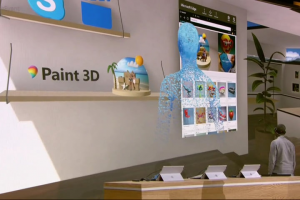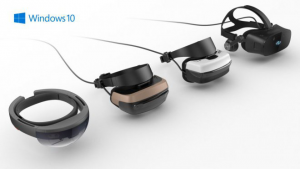Windows 10 VR
Introduction
.Windows 10 has received new virtual reality capabilities with the Windows 10 Creators Update. With this Windows update, Microsoft joins the list of technology companies that are invested in the virtual reality (VR) business. It allows for a device manufacturer to build a VR headset powered by Windows 10. Microsoft announced that companies like HP Inc, Lenovo, Dell, Acer, and ASUS would produce VR headsets based on the new Windows 10 feature [1] [2].
3D and virtual reality are at the heart of Microsoft’s plans for Windows 10, as the date of release of several low-cost VR headsets - designed to run the flagship OS - comes closer. Furthermore, these headsets will be capable of producing what Microsoft is calling ‘Mixed Reality’ experiences, in which the headsets can display both the physical and digital world, and intermix the two for user interaction [1] [3].
These Windows 10 VR headsets will arrive in 2017 and contain built-in sensors to enable inside-out, six-degrees of freedom for simplified setup. It also allows the user to more easily move around has he experiences the virtual worlds. The devices will sell for $300 and unlike other VR headsets such as the Oculus Rift, they will work with affordable laptops and PCs [1] [3].
A powerful VR headset like the Oculus Rift or HTC Vive requires powerful computers that are generally more expensive than what the average consumer would spend. Not only that, but the headsets themselves are expensive - something that can limit the market for virtual reality. The technology hasn’t been widely adopted yet and it is still a novelty rather than a mainstay. Therefore, to expand the VR market to the average consumer, Microsoft is investing in low-cost VR headsets powered by Windows 10 [1] [4] [5].
Some of the possible uses for VR and augmented reality (AR) headsets running Windows 10 were demonstrated during a Microsoft event in New York, in October of 2016. At the event, the company’s AR headset HoloLens was used to display Microsoft’s Edge browser. One of the forthcoming Windows 10 VR headsets was also shown and used to demonstrate a virtual space with virtual shelves stocked with apps and 3D models. The Edge browser appeared as a large window in this view (Figure 1). The last demonstration was Holotour, which is an interactive tourism site that allows various locations to be visited in VR [3].
The new headsets will be complemented by a series of Windows 10 new features that are focused on 3D content creation and sharing - part of the Windows 10 Creators Update. These include apps like Paint 3D, a new version of Microsoft Paint [3] [6].
Windows 10 VR headsets
Headsets
Acer Windows Mixed Reality Headset
HP Windows Mixed Reality Headset
Basic VR Headset Specs
- Dual displays at 1440 x 1440 per eye
- 2.89” diagonal display size (x2)
- Front hinged display
- 95 degrees horizontal field of view
- Display refresh rate up to 90Hz (native)
- Built-in audio out and microphone support through 3.5mm jack
- Single cable with HDMI 2.0 (display) and USB 3.0 (data) for connectivity
- Inside-out tracking
- 4.00m cable
The VR Headsets are all based on the Microsoft reference device.
Description
Besides the low-cost of the Windows 10 VR headsets (Figure 2), another characteristic that distinguishes them from other headsets like Oculus Rift or HTC Vive is the inside-out tracking sensors that obviate the need for external cameras or other tracking systems [7]. Furthermore, these headsets need to be tethered to PCs, which provide the computing power and contrasting with the HoloLens, which is a full-blown computer in a headset [8]. The simplicity of the plug-and-play in the new headsets could help it being adopted by the general audience since there is no need to set up multiple cameras, trackers, and wires [9].
Microsoft announced that the VR headsets are “Capable of mixed reality with the Windows 10 Creators Update.” The front cameras could possibly provide a live feed of the real world, with virtual imagery embedded on an overlay, something analogous to how Pokémon Go works on phones [10]. The Windows 10 VR headsets will be detected as soon as they are plugged into a Windows 10 PC. Drivers will also be installed automatically. Next, an area in which the users can play has to be set up, and the VR headset will scan and map the room, issuing a warning if the user steps out of the active area [8].
The headsets will work with Cortana, allowing the users to give commands or interact with content. Initially, they will support nine languages but more will be added. Other Windows 10 apps will be compatible with the headsets, like Skype. With the Creators Update, a “Movie and TV app” with 360-degree videos that can be viewed on the VR headset is available. The Edge Browser also has VR support, based on the WebVR standard. Besides all of this, Microsoft is also porting some HoloLens apps to the VR headsets [8].
Before the headsets are available to the public at the end of 2017, they will be available to developers in order to write and test applications based on the Windows VR platform [8]. Acer is one of the companies that partnered with Microsoft to create its line of the VR head-mounted displays and is one of the first to have a prototype for testing - the Acer's Windows 10 Headset [9].
To complement the headsets, there will be motion controllers available - the Windows Mixed Reality Motion Controllers [11].
Windows 10 VR requirements
- A dual-core Intel Core i5 with hyperthreading;
- Intel HD Graphics 620;
- 8GB of RAM;
- HDMI 1.4, HDMI 2.0, or DisplayPort 1.3;
- 100GB SSD (hard drives are not preferable but acceptable);
- Bluetooth 4.0. [12]
For Developers
- Intel Core i7 with six cores or more or an AMD Ryzen 7 1700 (8 core, 16 threads);
- Nvidia GeForce GTX 980, GTX 1060, or an AMD Radeon RX 480 (8GB);
- 16GB of RAM;
- At least 10GB of storage;
- Bluetooth 4.0, and one USB 3.0 standard port for the headset. [12]
Pre-Built PCs
Windows Mixed Reality PCs
Windows Mixed Reality PCs - desktops and laptops will allow the immersive headsets will run at 60 frames per second.
Specifications[13]
- Operating System: Windows 10 Fall Creators Update (RS3) - Home, Pro, Business, Education
- Processor: Intel Core i5 7200U (7th generation mobile), dual core with Intel® Hyper-Threading Technology enabled (or better)
- RAM: 8GB DDR3 dual channel (or better)
- Free disk space: At least 10 GB
- Graphics Card: Integrated Intel® HD Graphics 620 (or greater) DX12-capable integrated GPU (Check if your model is greater) NVIDIA MX150/965M (or greater) DX12-capable discrete GPU
- Graphics Driver: Windows Display Driver Model (WDDM) 2.2 (7/24/2017 or later)
- Graphics display port: HDMI 1.4 or DisplayPort 1.2
- Display: Connected external or integrated VGA (800x600) display (or better)
- USB connectivity: USB 3.0 Type-A or Type-C
- Bluetooth connectivity (for motion controllers): Bluetooth 4.0
- Expected headset framerate: 60 Hz
Windows Mixed Reality Ultra PCs
Windows Mixed Reality Ultra PCs - desktops and laptops that will allow the immersive headsets to run at 90 frames per second.
Specifications[13]
- Operating System: Windows 10 Fall Creators Update (RS3) - Home, Pro, Business, Education
- Processor: Intel Core i5 4590 (4th generation), quad core (or better) AMD Ryzen 5 1400 3.4Ghz (desktop), quad core (or better)
- RAM: 8GB DDR3 (or better)
- Free disk space: At least 10 GB
- Graphics Card: NVIDIA GTX 960/1050 (or greater) DX12-capable discrete GPU AMD RX 460/560 (or greater) DX12-capable discrete GPU GPU must be hosted in a PCIe 3.0 x4+ Link slot
- Graphics Driver: Windows Display Driver Model (WDDM) 2.2 (7/17/2017 or later)
- Graphics display port: HDMI 2.0 or DisplayPort 1.2
- Display: Connected external or integrated VGA (800x600) display (or better)
- USB connectivity: USB 3.0 Type-A or Type-C
- Bluetooth connectivity (for motion controllers): Bluetooth 4.0
- Expected headset framerate: 90 Hz
Accessories
Windows Mixed Reality Motion Controllers
Apps
Steam Games and Experiences
References
- ↑ 1.0 1.1 1.2 1.3 Vanian, J. (2016). Here’s how Microsoft is bringing virtual reality to Windows 10. Retrieved from http://fortune.com/2016/10/26/microsoft-virtual-reality-business/
- ↑ Griliopolous, D. (2016). What Windows 10 means for VR and AR. Retrieved from http://www.techradar.com/news/software/operating-systems/what-windows-10-means-for-vr-and-ar-1317919
- ↑ 3.0 3.1 3.2 3.3 Heath, N. (2016). Next spring, Microsoft will be releasing Windows 10 Creators Update, a 3D-focused revamp for its flagship OS. Retrieved from http://www.techrepublic.com/article/windows-10-to-get-3d-makeover-for-new-299-vrar-headsets/
- ↑ Estes, A. D. (2016). Microsoft wants to make VR cheap and easy with Windows 10. Retrieved from http://gizmodo.com/microsoft-wants-to-make-vr-cheap-and-easy-with-windows-1788234777
- ↑ Fuscaldo, D. (2017). Microsoft to include augmented reality in Windows 10 (MSFT). Retrieved from http://www.investopedia.com/news/microsoft-include-augmented-reality-windows-10-msft/
- ↑ Feltham, J. (2017). Windows 10 mixed reality support arrives next month. Retrieved from https://uploadvr.com/windows-10-mixed-reality-support-arrives-next-month/
- ↑ Robertson, A. (2016). Microsoft announces new VR headsets for Windows 10, starting at $299. Retrieved from https://www.theverge.com/2016/10/26/13418156/microsoft-windows-10-holographic-virtual-reality-headset-announced-price
- ↑ 8.0 8.1 8.2 8.3 Shah, A. (2017). Microsoft's first tethered Windows 10 VR headsets to ship in March. Retrieved from http://www.pcworld.com/article/3158222/virtual-reality/microsofts-first-tethered-windows-10-vr-headsets-to-ship-in-march.html
- ↑ 9.0 9.1 Hills-Duty, R. (2017). Acer reveal upcoming Windows 10 VR headset. Retrieved from https://www.vrfocus.com/2017/04/acer-reveal-upcoming-windows-10-vr-headset/
- ↑ Parrish, K. (2016). Windows 10 Creators Update bundles VR and AR, partner headsets start at $300. Retrieved from https://www.digitaltrends.com/virtual-reality/windows-10-creators-update-vr-ar-headsets-spring-2017/
- ↑ Hills-Duty, R. (2017). Pre-orders for Windows 10 VR development kits available. Retrieved from https://www.vrfocus.com/2017/05/pre-orders-for-windows-10-vr-development-kits-available
- ↑ 12.0 12.1 Paul, I. (2017). Here's what your PC needs to run Windows 10's Mixed Reality VR. Retrieved from http://www.pcworld.com/article/3196214/computers/heres-what-your-pc-needs-to-run-windows-10s-mixed-reality-vr.html
- ↑ 13.0 13.1 https://developer.microsoft.com/en-us/windows/mixed-reality/windows_mixed_reality_minimum_pc_hardware_compatibility_guidelines

